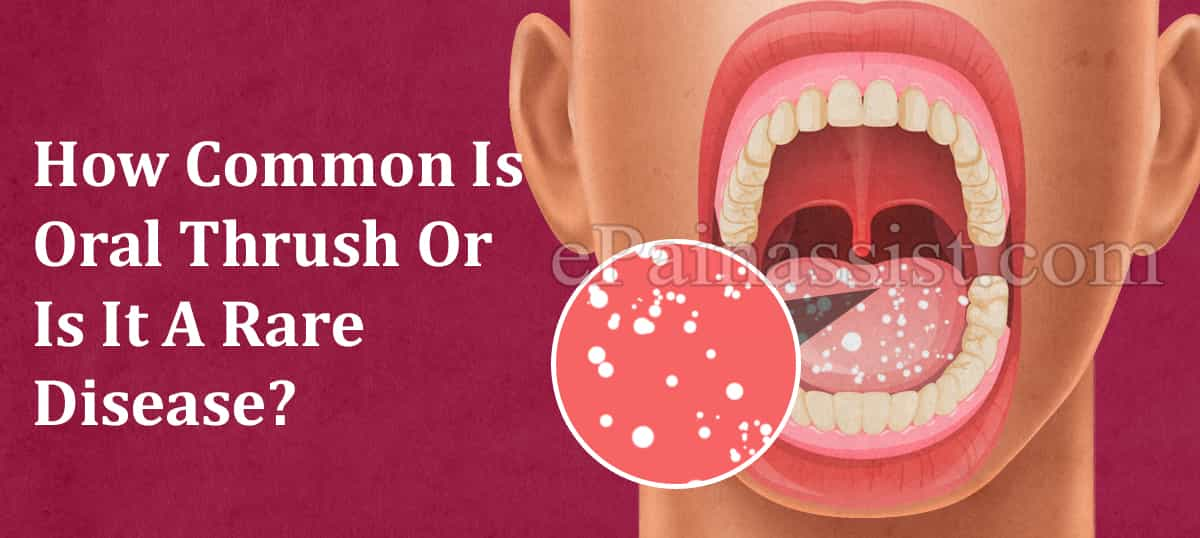Oral thrush (oral candidiasis) is an infection of the mouth and throat that is caused by candida fungi and is characterized by yellow-white spots in the oral cavity. Also, other organs such as the gastrointestinal tract, genital area or esophagus can be affected by the thrush.(1)
How Common Is Oral Thrush Or Is It A Rare Disease?
Oral thrush is most common in infants and the elderly, those who have weakened immune systems. But it can happen at any age. Young people develop thrush, especially if their immune system is weak. The severe form of oral thrush is rare. Babies less than two months old are more common to this disease as their immune system remains underdeveloped.

Research has shown that Candida infections have increased over the past ten to twenty years, with the transition from harmless to the symptomatic infection being very fluid. In babies, Candida fungi were detected in about 22 to 24 percent of all examined patients in the first two months, with 95% of the babies showing symptoms of an oral cavity. A very frequent occurrence of oral thrush also occurs in caries, in denture wearers, but also various underlying diseases.(1)
Oral thrush is mainly triggered by Candida fungi, which are among the so-called opportunistic pathogens, which means that they only trigger an infection if living conditions are very favorable. Many healthy adults have Candida fungi without causing symptoms or oral thrush. As long as the immune system is healthy, it can also keep the fungi at bay.(2)
Symptoms Of Oral Thrush
Acute oral thrush usually begins with reddening of the mucous membrane, which takes on a dry, shiny and smooth appearance over time. The tongue papillae often disappear with oral thrush. After about three to four days, pin-sized, irregular, whitish specks appear that resemble cotton and look creamy. A yellowish layer may also form and the white coverings can be seen.
Because the fungi are very active, bad breath can also occur in oral thrush and the body begins to fight the pathogens. So, the lymph nodes also swell, which indicates that the immune system is increasingly active. The damaged oral mucosa causes pain, which can be problematic especially for infants suffering since they are naturally more sensitive and often refuse to drink.
If the oral thrush is not treated in the early stages, the pathogens can spread. Possible secondary complications are vomiting and heartburn, which can add to the typical symptoms.(2)
Diagnosis Of Oral Thrush
To diagnose oral thrush, the doctor takes a smear as there are antigens in the blood if there is an infection. In the case of oral thrush, the material is removed where the pathogen probability is highest, e.g. from the white deposits or under the denture. The material is then analyzed under the microscope with the addition of a saline solution. Also, a fungus culture can be grown on a suitable nutrient medium to determine the type of pathogen.
Antibody detection in oral thrush is often relatively unreliable in immunosuppressed patients. When diagnosing oral thrush, the risk of invasive forms and chronic candidiasis should always be assessed.(3)
Treatment For Oral Thrush
Since oral thrush is usually very stubborn, medication is usually given with anti-fungal agents. These are available in the form of suspensions or ointments that are applied to the affected areas. If other organs or the intestine are affected by thrush, a stronger antifungal agent should be taken that works throughout the body. Adequate treatment time is also very important. Also, any type of medication should remain in the mouth for as long as possible. In oral thrush, nystatin, miconazole or amphotericin B are usually used in the form of lozenges or suspensions.
If oral thrush cannot be controlled with topical treatment, systemic therapy with azoles can also be indicated. Fluconazole is an effective drug.
In immunocompetent infants, the polygenes amphotericin B or nystatin are very suitable for treating oral thrush. For the supportive treatment of oral thrush, those affected can also regularly do mouthwashes with antifungal agents. (4)
- Vila T, Sultan AS, Montelongo-Jauregui D, Jabra-Rizk MA. Oral Candidiasis: A Disease of Opportunity. Journal of Fungi. 2020;6(1):15.
- Taylor M, Raja A. Oral Candidiasis (Thrush). StatPearls [Internet]: StatPearls Publishing; 2019.
- Rahmani F, Rezaei N. Refractory Oral Thrush. Pediatric Immunology: Springer; 2019:383-385.
- Porter S, Mercadante V, Fedele S. Oral manifestations of systemic disease. British dental journal. 2017;223(9):683.
Also Read:
- Oral Thrush: Causes, Risk Factors, Investigations, Treatment, Home Remedies, Prevention
- What are the Common Mouth Problems & What is its Cure?
- 5 Common Tongue Problems
- What Causes White Spots On The Tonsils & How To Manage It?
- What are the Causes of a Green Tongue, Know its Treatment, Complications, Prognosis
- What are the Causes of White Spots on Throat?
- Sore Throat Vs Strep Throat: Differences Worth Knowing
- What Are The First Symptoms Of Oral Thrush & How Do You Test For It?
- How Long Will It Take To Recover From Oral Thrush & How Long Does The Symptoms Last?
